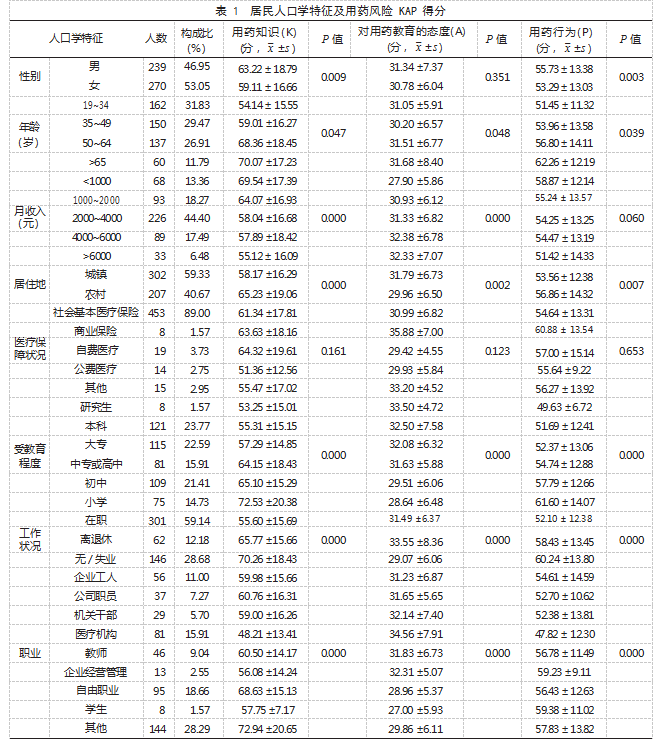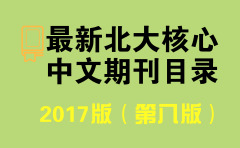河南省信阳市居民用药行为风险的影响因素论文
2023-09-22 15:02:41 来源: 作者:hemenglin
摘要:目的:探讨河南省信阳市居民用药行为风险的影响因素。方法: 2021 年 4 月至 2021 年 7 月在信阳市的八县三区各随机抽 取 50 名居民为研究对象(共 550 名)
【摘要】 目的:探讨河南省信阳市居民用药行为风险的影响因素。方法: 2021 年 4 月至 2021 年 7 月在信阳市的八县三区各随机抽 取 50 名居民为研究对象(共 550 名) ,现场发放《中国居民用药行为风险(KAP)调查问卷》,采用多重线性回归对其结果进行分析。 结果:共发放调查问卷 550 份, 获取有效问卷 509 份, 有效回收率为 92.55%。调查对象中女性占比 53.05%, 以 19~34 岁人群(31 .83%)为主, 月收入水平主要集中在 2000~4000 元(44.40%), 城镇居民(59.33%) 为主, 主要为社会基本医疗保险(89.00%), 受教育程度以本科 (23 .77%) 为主, 工作状况以在职人员(59.14%) 为主, 职业以其他(28.29%) 为主。居民用药知识平均得分为(61.04±17.79) 分, 评 价标准为良好;用药行为平均得分为(54.90±13.29)分, 评价标准为良好;对用药教育态度平均得分为(31 .05±6.70)分, 评价标准为及格; 男性、65 岁以上、月收入 1000 元以下、农村、小学、无 / 失业、职业为其他的居民用药知识得分均高于其余人群, 男性、65 岁以上、农村、 小学、无 / 失业、职业为学生的居民用药行为得分均高于其余人群, 19~34 岁、月收入 1000 元以下、农村、小学、无 / 失业、职业为学生 的居民对用药教育态度得分均低于其余人群,差异有统计学意义(P<0.05) 。性别、年龄、受教育程度、工作状况均为居民用药知识的影 响因素(P<0.05);受教育程度为居民用药态度的影响因素( P<0.05);性别、年龄、受教育程度为居民用药行为的影响因素( P<0.05)。 结论: 男性、65 岁以上、受教育程度低、无 / 失业人群均为影响居民用药的风险因素。
【关键词】 居民,用药知识,用药行为,用药教育态度,风险,影响因素
Influencing factors of medication behavior risk among residents in Xinyang city of
Henan Province
HE Yan, DUAN Zhenzhen, ZHENG Nannan, LIU Rupin, MOU Xiaodong, HU Wei, YANG Jinlan, REN Qi
(Department of Pharmacy of Xinyang Central Hospital, Xinyang 464000 Henan, China)
【 Abstract 】 Objective: To explore influencing factors of medication behavior risk among residents in Xinyang city of Henan Province. Methods: From April 2021 to July 2021. 50 residents (a total of 550) were randomly selected from each of the eight counties and three districts in Xinyang city. The Knowledge Attitudes Practices (KAP) survey questionnaire for Chinese residents was distributed on-site, and the results were analyzed using multiple linear regression. Results: A total of 550 survey questionnaires were distributed, and 509 valid questionnaires were obtained with a recovery rate of 92.55%. The subjects of survey was mainly female residents (53.05%), those among the 19-34 year old (31.83%), those with the per capita income level of 2000-4000 yuan (44.4%), urban residents (59.33%), those with social basic medical insurance (89.00%), those with the education level of mainly undergraduate (23.77%), those with the work status of mainly in-service personnel (59 . 14%), and those with the occupation of mainly others (28 .29%) . The average score of the residents’ medication knowledge was (61.04 ± 17.79) points, which was good; the average score of medication behavior was (54.90 ± 13.29) points, which was good; and the average score of attitude towards medication education was (31.05 ± 6.70), which was qualified. The medication knowledge scores of the male residents, the residents aged 65 and above, the residents with the income of less than 1000 yuan, the residents in the rural areas, the residents with the education level of primary schools, the residents without job/unemployed, and the residents with the other professions were higher than those of the rest of the population; the scores of medication behavior of the male residents, the residents over 65 years old, the residents in the rural areas, the residents with the education level of primary schools, the residents without job/unemployed, and the residents whose occupation were students were higher than those of the rest of the population; the scores of the attitudes towards medication education of the residents aged 19-34 years old, the residents with the income of less than, the residents in the rural areas, the residents with the education level of primary schools, the residents without job/unemployed, and the residents whose occupation were lower than those of the rest of the population; and the differences were statistically significant (P<0.05). Gender, age, education level, and work status are all influencing factors for the residents’ medication knowledge (P<0.05); the education level was the influencing factor of the residents’ attitudes towards medication (P<0.05); gender, age, and education level were the influencing factors of the residents’ medication behavior (P<0.05). Conclusions: Male, the residents aged 65 and above, poorly educated, and no job/unemployed are all the risk factors affecting the residents’ medication behaviors.
【Keywords】 Resident; Medication Knowledge; Medication behavior; Attitude towards medication education; Risk; Influence factor
药品在保障人类健康、预防和治疗疾病方面发 挥着巨大的作用。用药行为是指药品使用者对药品 的认知、观念、行为习惯等方面表现出来的特征。 随着居民“自我药疗”现象的普遍,目前促进居 民安全用药至关重要 [1]。知 - 信 - 行(knowledge- attitudes-practices, KAP) 理论将人的行为改变分 为获得知识、产生信念、形成行为三个连续的过程, 是了解人对于某种事物的知识、态度及行为影响的 一种方式 [2] 。运用“知 - 信 - 行”理论对河南省信 阳市居民的用药知识、态度和行为进行调查,可分 析影响其用药行为的风险因素。本文探讨河南省信 阳市居民用药行为风险的影响因素。
1 资料与方法
1.1 一般资料 2021 年 4 月至 2021 年 7 月, 分别 在信阳市的八个县和三个行政区各随机抽取 50 名 居民为研究对象。纳入标准:信阳市八县三区居 民;年龄≥ 19 岁。排除标准:存在阅读或理解能 力障碍。
1.2 方法
1.2.1 问卷内容 采用中国药学会全国医药经济信 息网 2021 年度科普研究项目指南统一设计的《中 国居民用药行为风险 KAP 调查问卷》,由培训合 格的药学人员采用通俗易懂的语言解释《问卷》内 容, 包括: (1)居民基本信息(性别、年龄、收入、 居住地、医疗保障状况、受教育程度、工作状况和 职业等 8 个问题) 。(2) 居民用药知识(K; 自我 药疗时所用药物使用方法、用药时间、用药禁忌、 药物储存及药物不良反应等 28 个问题)。(3) 居 民用药行为(P;用药前阅读药物说明书、检查药 物有效期、定期清理过期药物、用药管理与合理用 药行为等 24 个问题) 。(4)居民对用药教育的态 度(A;参加用药教育活动的频率及对开展用药教 育的看法等 11 个问题)。
1.2.2 研究方法 采用线下发放纸质调查问卷的形 式,在信阳市八县三区各随机选取一个人员流动性 较大的广场或商场, 在获得被调查者同意后进行, 指导其以匿名的方式填写,问卷当场收回。
1.2.3 问卷质量控制 由培训合格的药学人员对收 回问卷进行审核,剔除填写内容不完整、多选、少 选、选项完全相同、问题选项与答案存在明显逻辑 关系错误或自相矛盾的问卷。
1.3 问卷结果评价标准 居民用药知识(K)部 分共 28 题,将赞同程度用数字来量化,均采取反向计分,分值越大表示赞同程度越高。 “极不赞 同” 计 1 分, “不赞同”计 2 分, “一般 / 不清 楚”计 3 分, “赞同”计 4 分, “极为赞同”计 5 分。计算得分, 28~56 分为优秀, 57~84 分为良好, 85~112 分为及格,≥ 113 分为不及格,得分越高 表明居民用药风险越高。
居民用药行为(P)部分共 24 题,将实际发生 频率用数字来量化,大部分问题采取反向计分,分 值越大表示发生频率越高。但以下 8 题为正向问题, 如问卷中:使用药物前存在以下问题吗? (1)对 家里存放的药品进行定期检查; (2)观察说明书 中药品储存条件; (3)看一下药品副作用以及出 现副作用后的表现; (4)了解使用某个药物时的 禁忌事项(喝酒、驾驶等) ; (5)服用药品前观 察药品有效期; (6)在服用药品之前查阅药品包 装上的药品批准文号。服用药物时存在以下问题吗? (7)将家里过期的药品丢弃在垃圾箱里; (8)用 药时,每次都会考虑自身身体状况。将所有正向问 题的得分按反向问题计算分数,如问题“观察说明 书中药品储存的条件”, 若选择“总是”时计 5 分, 改为反向问题后则计 1 分;若选择“经常”时计 4 分,改为反向问题后则时计 2 分;若选择“时常 / 不清楚”时计 3 分,改为反向问题后仍计 3 分;若 选择“偶尔”时计 2 分, 改为反向问题后则计 4 分; 若选择“从不”时计 1 分,改为反向问题后则计 5 分。计算得分, 24~48 分为优秀, 49~72 分为良好, 73~96 分为及格,≥ 97 为不及格,得分越高表明 居民用药风险越高。
居民对用药教育的态度(A) 部分共 11题,包 括实际解除或开展教育活动频率、对开展教育活动 的必要性看法两个部分,均采取正向计分,得分 44~55 分为优秀, 33~43 分为良好, 22~32 分为及 格, ≤ 21 分为不及格,得分越高表明居民用药风 险越低。
1.4 统计学方法 采用 SPSS 22.0 统计学软件分析 数据,计量资料以( x(—) ±s )表示,采用多重线性回 归分析居民用药 KAP 的影响因素, 以 P<0.05 为差 异有统计学意义。
2 结果
2.1 居民人口学特征 共发放调查问卷 550 份, 最终获取有效问卷 509 份,有效回收率为 92.55% (509/550) 。调查对象中女性占比 53.05%,以 19~34 岁人(31.83%) 为主,月收入水平主要集中在 2000~4000 元(44.40%) ,城镇居民(59.33%) 为主,主要 为社会基本医疗保险(89.00%) ,受教育程度以本 科(23.77%) 为主,工作状况以在职人员(59.14%) 为主,职业以其他(28.29%)为主。见表 1.
2.2 居民用药风险 KAP 得分情况
2.2.1 用药知识(K)得分情况 居民用药知识平 均得分为(61.04±17.79)分,评价标准为良好。 男性、65 岁以上、月收入 1000 元以下、农村、小学、 无 / 失业、职业为其他的居民用药知识得分均高于其余人群,差异有统计学意义(P<0.05)。见表 1. 2.2.2 用药行为(P)得分情况 居民用药行为平 均得分为(54.90±13.29)分,评价标准为良好。 男性、65 岁以上、农村、小学、无 / 失业、职业为 学生的居民用药行为得分均高于其余人群,差异有 统计学意义(P<0.05)。见表 1.
2.2.3 对用药教育的态度(A)得分情况 居民对 用药教育的态度平均得分为(31.05±6.70)分,评 价标准 为及格。19~34 岁、月收入 1000 元以下,农村、小学、无 / 失业、职业为学生的居民对用药 教育的态度得分均低于其余人群,差异有统计学意 义(P<0.05)。见表 1.

2.3 居民用药风险 KAP 影响因素分析 以居民用药知识、行为、态度得分作为因变量,以性别、年 龄、月收入、居住地、受教育程度、工作状况和职 业为自变量,进行多重线性回归分析。具体结果见 表 2.
2.3.1 居民用药知识(K)的影响因素 由表 2 可 知,性别、年龄、受教育程度、工作状况为居民用 药知识的影响因素(P<0.05 )。
2.3.2 居民用药态度(A)的影响因素 由表 2可知,受教育程度为居民用药态度的影响因素 ( P<0.05 )。
2.3.3 居民用药行为(P)的影响因素 由表 2 可 知,性别、年龄、受教育程度为居民用药行为的影 响因素(P<0.05 )。

3 讨论
本研究结果显示,居民用药知识、用药行为评 价标准均为良好,用药教育态度评价标准为及格。 提示信阳市八县三区居民用药知识和用药行为较 好,但用药教育态度亟待改进。
本研究居民用药知识影响因素分析结果显示, 男性、65 岁以上、小学、无 / 失业为居民用药知识 的影响因素,且该类人群用药风险较大。分析原因 为日常生活中男性细心程度不如女性,不会过多注 重用药的安全性;老年人基础疾病多,用药种类多 且复杂,多凭经验用药,或听信日常生活中一些虚 假广告和宣传,导致用药风险增大 [3] ;受教育程度 低的人群普遍从事体力劳动,日常工作强度大,缺 少时间关注比较专业的药品说明书、药品相关知识 的宣传等;无 / 失业人群普遍受教育程度低,缺少 获取用药知识的相关途径 [4]。
本研究居民用药态度影响因素分析结果显示, 小学为居民用药态度的影响因素,且该类人群用药 风险较大。分析原因为受教育程度较低的人群通常 对用药教育不感兴趣,不重视用药的合理性。
本研究居民用药行为影响因素分析结果显示,男性、65 岁以上、小学为居民用药行为的影响因素, 且该类人群用药风险较大。分析原因为男性在用药 时不会过多注意细节;老年人群身体机能减退,多 存在视物模糊,可造成用药说明书阅读错误情况发 生 [5-6] ;受教育程度低的人群多偏听偏信他人的用 药经验,易受他人影响,导致用药风险增大。
由上述结果得出,今后需加强用药相关知识 的科普宣传及服务,在进行用药安全宣传时,应更 有倾向性地针对男性、65 岁以上、受教育程度低、 无 / 失业人群,同时应采用简明易懂的语言或生动 有趣的图片、视频等形式,增加宣传趣味性,增加 居民对用药知识教育的兴趣,降低居民用药风险。
综上所述,男性、65 岁以上、受教育程度低、 无 / 失业人群均为影响居民用药行为的风险因素。
参考文献
[1] 王继美,任燕,李莉,等 . 2019 年东营市居民用药风险知信行调查及影响因素研究 [J]. 药物流行病学杂志, 2020.29(9):610-615.
[2] Shraim NY, Al Taha TA, Qawasmeh RF, et al. Knowledge, attitudes and practices of community pharmacists on generic medicines in Palestine: a cross-sectional study[J]. BMC Health Serv Res, 2017. 17 (1): 847.
[3] 张佳颖,郭西芮,吴行伟,等 . 居民用药风险 " 知识 - 态度 -行为 " 调查及影响因素研究 [J]. 中国药房, 2018. 29 (11):1445-1448.
[4] 李燕菊,焦敏,滕威,等 . 新疆多地居民用药风险 KAP 调查及其影响因素研究 [J]. 药物流行病学杂志,2021.30(5): 317-320.
[5] 冉海龙,董育珠,杜倩,等 . 重庆市居民用药行为风险 KAP 的调查研究 [J]. 临床医学研究与实践, 2021. 6 (14): 22-26.
[6] 苏美琴,丁记者,欧阳华 . 基于 "KAP”理论对厦门市社区居民用药风险调查及影响因素研究 [J]. 中国医院药学杂志, 2020. 40 (12): 1375-1379.










